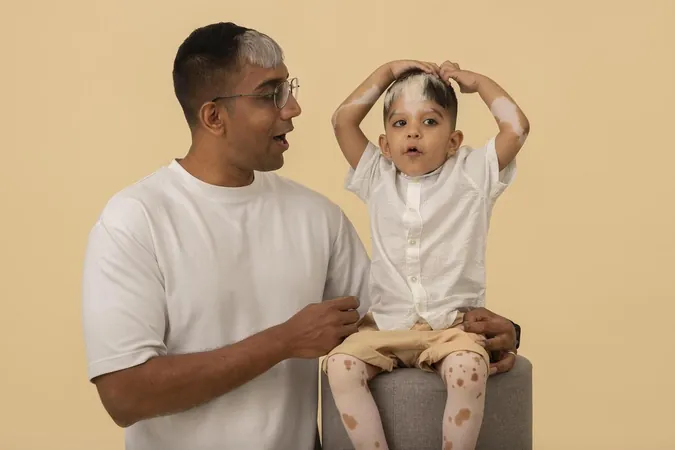
Piebaldism: The Real-Life X-Men in Our Midst!
2025-04-05
Author: Jia
SINGAPORE - Meet toddler Mohamed Zain Azharuddin, whose striking white forelock and patchy skin make him a real-life embodiment of Marvel Comics' X-Men character Rogue. Yet, much like any exuberant toddler, Zain is blissfully unaware of the curious glances he sometimes attracts.
Zain’s father, 37-year-old Mr. Azharuddin Mohamed Naseem, shares a beautiful bond with his son as he dyed his own hair to match Zain’s unique look. “I never wanted my son to feel alone in this,” he explains. “When Zain was two, he noticed his white hair next to my dark locks in the mirror, and I could tell he felt confused. I decided then that I would bleach my forelock to match his. Now people see us together and say, ‘like father, like son,’ but I tell them it’s actually the other way around. It’s become a special way to normalize his condition and strengthen our relationship.”
Zain’s condition, known as piebaldism, is a rare genetic disorder that leads to patches of skin and hair lacking pigment.
This striking appearance is due to a mutation in a gene crucial for pigment cell development. Zain’s birthmarks aren’t limited to his hair; they also appear on his arms, stomach, and legs. According to Mr. Azharuddin, the family wasn’t completely taken aback since his wife’s family has a history of piebaldism, though they were surprised at the extent of Zain's condition.
Stefanie Dowideit, 17, also has piebaldism.
Unlike her fraternal twin sister, Stephanie, who has a typically pigmented appearance, Stefanie has embraced her uniqueness. “I realized early on that I looked different from my sister, but that never changed our bond as sisters.”
The odds of having this condition are quite rare—affecting less than 1 in 20,000 people, with variations across different racial backgrounds.
Dr. Mark Koh, an associate professor and head of dermatology at KK Women’s and Children’s Hospital in Singapore, explains that piebaldism occurs due to a mutation that stops the formation of melanocytes, the cells responsible for producing melanin, resulting in the characteristic white patches.
While piebaldism has no associated systemic health issues, Dr. Koh urges parents to protect their children from excessive sun exposure.
This can cause sunburn on the unprotected skin areas. Although some treatment options like camouflage makeup and skin grafting are available, the latter can be notoriously challenging, and outcomes can vary.
Not just a human condition, piebaldism also appears in various mammal species, notably among domesticated animals.
Breeders often select these distinctive traits, leading to a higher prevalence in certain breeds.
Children with piebaldism, however, can face significant social challenges.
American model Rebecca Heckard was bullied in school and referred to as “skunk” because of her distinctive appearance. In contrast, Stefanie reflects on a more inclusive experience, highlighting that her peers never treated her differently, even as she entered the competitive environment of junior college. “Everyone was very nice,” she recalls. “I was initially worried about how people would react, but they were respectful and curious in a good way.”
Zain is currently thriving in nursery school at Masjid Kampung Siglap Kindergarten, where his teacher has taken proactive steps to educate classmates about his condition.
Ensuring they understand and accept him. “At this young age, children are wonderfully accepting. They view differences as part of who someone is,” Mr. Azharuddin shares.
Stefanie’s life, as she asserts, isn't so different from her peers.
“I got to do most of the fun activities like everyone else, although I had the added hassle of wearing hats to protect my skin from the sun. That was definitely annoying!” she laughs.
In an effort to promote awareness about rare skin conditions, local organizations, including the Rare Skin Conditions Society (Singapore) and DEBRA Singapore, will launch an insightful book titled *The Skin We Wear: A Photo Story of Skin and Kin* on May 2, 2025.
As piebaldism continues to garner attention, it serves as a poignant reminder of the beauty in our differences and the importance of embracing our unique identities—just like Zain and Stefanie.

 Brasil (PT)
Brasil (PT)
 Canada (EN)
Canada (EN)
 Chile (ES)
Chile (ES)
 Česko (CS)
Česko (CS)
 대한민국 (KO)
대한민국 (KO)
 España (ES)
España (ES)
 France (FR)
France (FR)
 Hong Kong (EN)
Hong Kong (EN)
 Italia (IT)
Italia (IT)
 日本 (JA)
日本 (JA)
 Magyarország (HU)
Magyarország (HU)
 Norge (NO)
Norge (NO)
 Polska (PL)
Polska (PL)
 Schweiz (DE)
Schweiz (DE)
 Singapore (EN)
Singapore (EN)
 Sverige (SV)
Sverige (SV)
 Suomi (FI)
Suomi (FI)
 Türkiye (TR)
Türkiye (TR)
 الإمارات العربية المتحدة (AR)
الإمارات العربية المتحدة (AR)